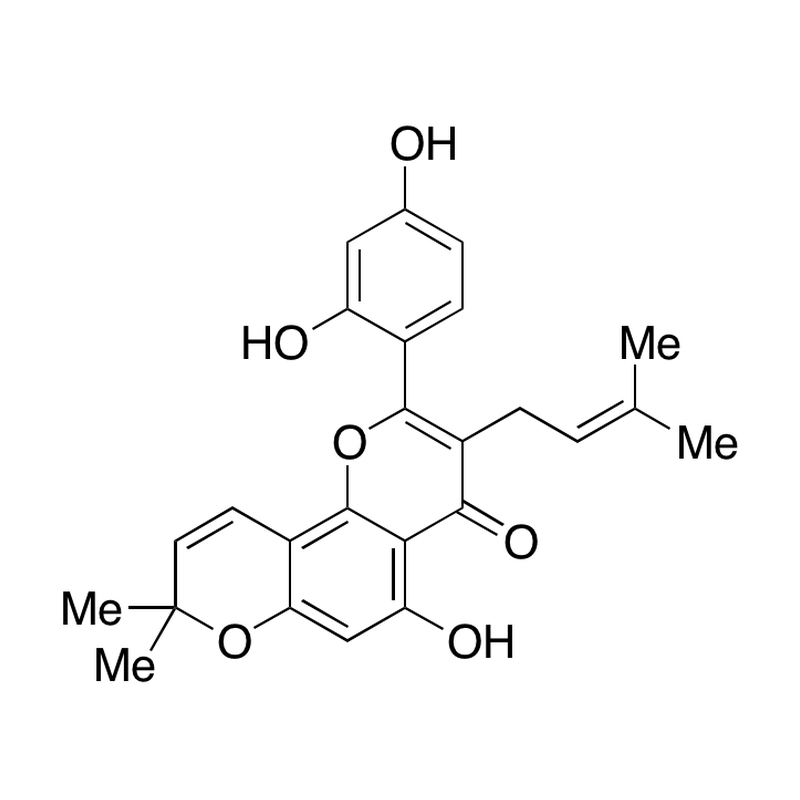产品
编 号:F409588
分子式:C25H24O6
分子量:420.45
分子式:C25H24O6
分子量:420.45
产品类型
规格
价格
是否有货
10mM*1mL in DMSO
询价
询价
5mg
询价
询价
10mg
询价
询价
25mg
询价
询价
结构图

CAS No: 62596-29-6
产品详情
生物活性:
Morusin is a prenylated flavonoid isolated from Morus alba Linn. with various biological activities, such as antitumor, antioxidant, and anti-bacteria property. Morusin could inhibit NF-κB and STAT3 activity.
体内研究:
Morusin retards the growth of breast cancer significantly. Mean tumor weight of the control mice is 1.14±0.30 g, and those of the mice administrated with 5 and 10 mg/kg of morusin are 0.61±0.23 and 0.41±0.10 g, respectively, tumor inhibitory rates are 46.5 %, and 64.1 %, respectively.
体外研究:
Morusin exhibits a dose- and time-dependent inhibitory effect on murine and human breast cancer cells. IC50 is 9.48 μg/mL for normal mammary epithelial cells (MCF-10A); 2.03 and 1.87 μg/mL for murine breast cancer cells (4 T1 and EMT6); and 2.71 and 3.86 μg/mL for human breast cancer cells (MCF-7 and MDA-MB-231), respectively, the maximal inhibition of cell growth (>80 %) is obtained at 8 μg/mL. The apoptotic cells in morusin treated breast cancer cells are increased significantly in a dose-dependent manner. Morusin significantly inhibits the growth and clonogenicity of human colorectal cancer HT-29 cells. Morusin also inhibits the phosphorylation of IKK-α, IKK-βand IκB-β, increases expression of IκB-α, and suppresses nuclear translocation of NF-κB and its DNA binding activity. Dephosphorylation of NF-κB upstream regulators PI3K, Akt and PDK1 is also displayed. In addition, activation of caspase-8, change of mitochondrial membrane potential, release of cytochrome c and Smac/DIABLO, and activation of caspase-9 and -3 are observed at the early time point. Downregulation in the expression of Ku70 and XIAP is exhibited afterward. Morusin suppresses viability of prostate cancer cells, but little effect in normal human prostate epithelial cells. Morusin also reduces STAT3 activity by inhibiting its phosphorylation, nuclear accumulation, and DNA binding activity. In addition, morusin down-regulated expression of STAT3 target genes encoding Bcl-xL, Bcl-2, Survivin, c-Myc and Cyclin D1. It induces apoptosis in human prostate cancer cells by reducing STAT3 activity.
Morusin is a prenylated flavonoid isolated from Morus alba Linn. with various biological activities, such as antitumor, antioxidant, and anti-bacteria property. Morusin could inhibit NF-κB and STAT3 activity.
体内研究:
Morusin retards the growth of breast cancer significantly. Mean tumor weight of the control mice is 1.14±0.30 g, and those of the mice administrated with 5 and 10 mg/kg of morusin are 0.61±0.23 and 0.41±0.10 g, respectively, tumor inhibitory rates are 46.5 %, and 64.1 %, respectively.
体外研究:
Morusin exhibits a dose- and time-dependent inhibitory effect on murine and human breast cancer cells. IC50 is 9.48 μg/mL for normal mammary epithelial cells (MCF-10A); 2.03 and 1.87 μg/mL for murine breast cancer cells (4 T1 and EMT6); and 2.71 and 3.86 μg/mL for human breast cancer cells (MCF-7 and MDA-MB-231), respectively, the maximal inhibition of cell growth (>80 %) is obtained at 8 μg/mL. The apoptotic cells in morusin treated breast cancer cells are increased significantly in a dose-dependent manner. Morusin significantly inhibits the growth and clonogenicity of human colorectal cancer HT-29 cells. Morusin also inhibits the phosphorylation of IKK-α, IKK-βand IκB-β, increases expression of IκB-α, and suppresses nuclear translocation of NF-κB and its DNA binding activity. Dephosphorylation of NF-κB upstream regulators PI3K, Akt and PDK1 is also displayed. In addition, activation of caspase-8, change of mitochondrial membrane potential, release of cytochrome c and Smac/DIABLO, and activation of caspase-9 and -3 are observed at the early time point. Downregulation in the expression of Ku70 and XIAP is exhibited afterward. Morusin suppresses viability of prostate cancer cells, but little effect in normal human prostate epithelial cells. Morusin also reduces STAT3 activity by inhibiting its phosphorylation, nuclear accumulation, and DNA binding activity. In addition, morusin down-regulated expression of STAT3 target genes encoding Bcl-xL, Bcl-2, Survivin, c-Myc and Cyclin D1. It induces apoptosis in human prostate cancer cells by reducing STAT3 activity.
产品资料

